All Fotos Copyright Jonathan Alpeyrie
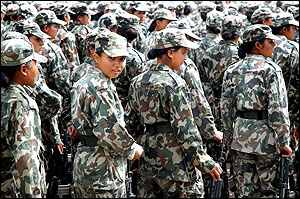
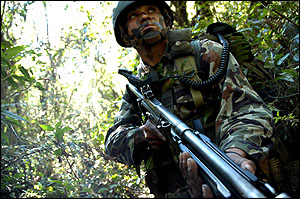
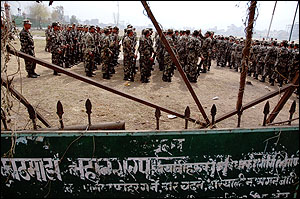
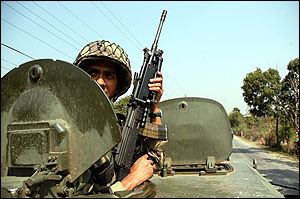
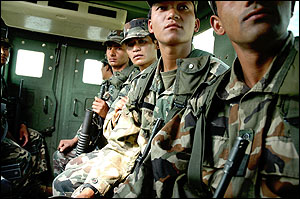
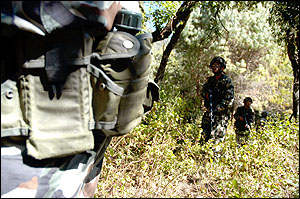
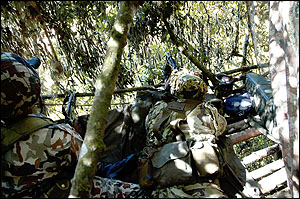

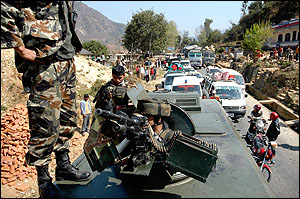
|
Nepal’s war
Article by Jonathan Alpeyrie.
March 2005
Nepal’s conflict is probably one of the least understood wars at this time. Indeed the details on the conditions of civilian livelihood in the combat areas, as well as the tactics, operations employed, and weaponry used by both sides is equally unknown. This 10-year-old guerrilla war, which so far has claimed almost than 12 thousand lives, mostly civilians, does not show any signs of quieting down. In fact the war has intensified with the new Maoist offensive of early 2000. Both sides are getting better at waging war, and recruiting has been broadened to the entirety of the country. The Royal Nepalese army (RNA) has trained and armed a further 15 thousand men, adding to the already existing 78 thousand. Field tactics are also changing. First introduced by the Maoists insurgents, guerrilla tactics have been used to their full advantage again the RNA, which in turn was forced to rethink its fighting potential. King Gyanendra and his government, as chief of the army has failed to understand the gravity of the political and military situation of the war. Corruption and drastic political measures, such as the dissolution of the government by the king on February 1st 2005, and the imprisonment of most of the opposition, all have contributed in making the Maoists feel more confident about their fight to destroy the Royal authority. They see these political moves as a direct threat to Nepali social integrity. To this date no compromise has neither been found nor wished.
The rise of the conflict goes hand-to-hand with the political ambiance in the country. The renewal of the Maoist offensive in January 2000 has forced the government and its army to change the way they deal with their opponent. In order to contain the rebellion, army headquarters based in Kathmandu has sent officers back to school at Fort Braggs in California for commando and Ranger training, who in turn trained a new generation of elite officers in Nepal. One battalion of one thousand men was formed as a quick reaction force trained to intervene in any situation anywhere in the country with the help of a small fleet of seventeen helicopters. Two more battalions, a Special Forces, and a paratrooper formation, were formed and trained in the same fashion the latter by Israelis. This three thousand men force helps to bolster regular army units embroiled in the fighting.
Most of the fighting in confined in the Western Terai regions of Nepal. The Western Terai, the center of the Maoist rebellion has seen heavy combat between the two forces. The RNA has had a tough time so far. The hilly region offers a perfect fighting area for the rebels who can melt away in the pro-Maoist population. This has led to abuses on both sides. The population, which has found itself in the middle of the fighting, has had to choose sides, often by force. Maoist rebels enter a village giving no choice to the villagers who have to help by feeding them, provide shelter and a tactical apparatus from where they can defend themselves. Government forces always in search for further information on their enemy will threatened these same villagers by accusing them of treachery. These civilians has no choice by to help which ever side comes first to their village. Today, Nepal has the worst disappearance record, with more than 1200 people unaccounted for. However it is fair to say that both sides have been behaving equally ruthlessly towards their fellow citizens. So far in the Western Terai, the RNA has been fighting a loosing battle. The population in the remote areas of the Terai, like in Rolpa district, the population is pro Maoist by choice but more often by necessity. The Maoists will provide an organized social and economic apparatus, something the government has never been able to do in these far off regions of Nepal. The government is fighting the worst kind of war, fighting a hostile population, supported by militias and PLA fighters. Various massacres orchestrate by RNA units has not helped them in taming the rebellion there. Its units lack the proper experience to deal with a population, which has had little governmental influence for the past 50 years or so. A rather surprising element as many Nepali veterans were trained in the UK, and fought with the British in Brunei during the mid 70’s, promptly defeating a tough guerrilla opponent. Indeed, the British army is the only army, which has been able to win a guerrilla war in the past 40 years.
During the latest Maoist appeal for a general strike in February 2005, elements of these elite formations were once more asked to help in the removal of rebel roadblock on the two main highways. The Mahendra Highway, bearing the name of the defunct king, connecting the country on an East West axis as far as Nepalganj in Western Dang district fell victim to the blockade. Makeshift roadblock are constructed by Maoists rebels to stop all commercial and military traffic forcing RNA units to intervene and reopen the road by force. Indeed Maoists rebels will wait in hiding in neighboring hills and forest, ambushing any military personnel. This new tactic first introduced during the 2001 rebel offensive was very effective. For the past two years however, RNA tacticians have used their superior training to their advantage. Indeed, RNA units do not anymore walk blindly into these road-side ambushes, instead mixed element of elite forces, regular soldiers, and security forces personnel reconnoiter the neighboring hills during Search and destroy operations making sure no insurgents are present in the area. Yet guerrilla type warfare do not assure any such certainties, and ambushes are quite common. The second most important road, the Tribhuvan highway, is also victim to such combat. This smaller road, which connects Kathmandu to Northern India through the major Nepali city of Birganj, is the only route between the two countries for fuel commercial activities. On the evening of February 28th, Maoists rebels operating in that region built a few roadblocks and took up positions near the highway, effectively stopping all commercial traffic, and waited for the RNA’s response. Unfortunately for the RNA, the only unit present in the region a small infantry regiment 800 hundred strong, not enough to find the 300 or so Maoists fighting in the region. A military convoy was put together to escort commercial private traffic to and from India. A dozen or so Indian built armored vehicle alongside a few hundred men, including a company of Rangers, set up to move South and reopen the road by force. The rebels were waiting, they ambushed the first convoy killing 8 soldiers, wounding another three, and destroying no less than half a dozen commercial trucks. A company was sent in to locate and destroy the attackers, none were found except for their 12 dead left behind.
These operations are typical of a war of attrition between Gyanendra’s powerhouse and Maoists rebels. Both sides have acquired experience, plenty of weapons, and new recruits. The already 78 thousand strong RNA forces has lured another 15 thousand or so new recruits with the help of promises such as a 50$ monthly pay and free Medicare for them and their families. This kinds of governmental promises has had great successes to attract further recruits, as most Nepalese are poor and live with less than 20 dollars a month. Most Nepalese join the RNA not for patriotic reasons but for lucrative ones, to feed their families, and potentially climb the social ladder. The tough social cast system imposed on Nepal’s citizens does not allow for economic prosperity. The Dalit, or untouchables, find themselves at the bottom of the economic ladder, the army however does not differentiate between Dalit and Brahman (the highest cast in Nepal), the army takes all who are whiling to fight for the king.
No end is in sight for the war in Nepal. Both sides have strengthened their military and political positions. The king with the dissolution of the parliament has taken full control on the government; the Maoists have secured a large powerbase in the Western Terai, effectively creating a small country within Nepal. The rise of both the Maoists and king Gyanendra geo-political power is a clear sign that Nepal is falling further into chaos. India which has been selling weapons along with the United States to RNA, have agreed to stop the sells in protest of the king’s erratic political decisions. However, India, which has been dealing, in fact quite unsuccessfully, with its own Maoists movement has played a rather unclear role in the Nepal war. It is true that India has been selling a lot of weapons, including all 17 helicopters of the RNA air force, but done nothing else to secure its border with Nepal. Maoists get most of their weapons from Northern India where Indian Maoists operate, buying off Indus border officers. The Indian government has done nothing to punish its officers responsible for making it easy to smuggle weapons into Nepal. Why? It is probably safe to say that India has an interest to see its neighbor destabilized, therefore eradicating regional competition, like in Kashmir and Bangladesh. However India’s political agenda, the war in Nepal will drag on for years to come, taking many more innocent lives.
Jonathan Alpeyrie March 2005
|

